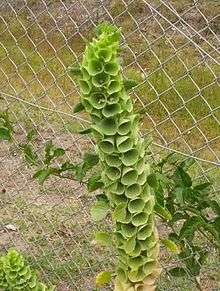Moluccella laevis
Moluccella laevis, the Bells-of-Ireland, Bells of Ireland, Molucca balmis, shellflower or shell flower, is a summer flowering annual, native to Turkey, Syria and the Caucasus. It is cultivated for its spikes of flowers. In the language of flowers, it represents luck.
| Moluccella laevis | |
|---|---|
 | |
| Persistent calyces | |
| Scientific classification | |
| Kingdom: | Plantae |
| Clade: | Tracheophytes |
| Clade: | Angiosperms |
| Clade: | Eudicots |
| Clade: | Asterids |
| Order: | Lamiales |
| Family: | Lamiaceae |
| Genus: | Moluccella |
| Species: | M. laevis |
| Binomial name | |
| Moluccella laevis | |
The tiny white flowers are surrounded by apple green calyces which are persistent. The rounded leaves are pale green.
Fast growing, Moluccella laevis will reach 1 metre (3.28 feet) and spread to 30 centimeters (11.8 inches) with an erect, branching habit.[1]
A member of the mint family, the blooming stems can be cut and used in fresh or dried flower arrangements. The domestic plant is self-seeding, prefers full sun and regular water and are unlikely to do well in hot, humid climates.
External links
- Jepson Manual Treatment
- "Moluccella laevis". Germplasm Resources Information Network (GRIN). Agricultural Research Service (ARS), United States Department of Agriculture (USDA).
- Wisconsin Master Gardener Features: Bells of Ireland
- USDA Plants Profile
- Photo gallery
- Moluccella laevis Flowers in Israel
References
- Botanicas, Annuals and Perennials, Random House, Sydney, 2005
| Wikimedia Commons has media related to Moluccella laevis. |